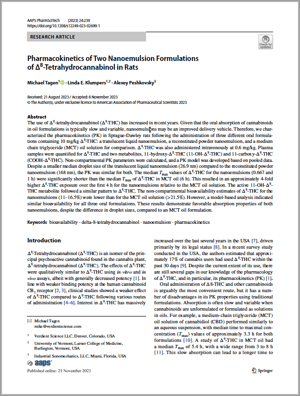Michael Tagen, Linda E. Klumpers, Alexey S. Peshkovsky, AAPS PharmSciTech, November 2023.

The use of Δ8-tetrahydrocannabinol (Δ8-THC) has increased in recent years. Given that the oral absorption of cannabinoids in oil formulations is typically slow and variable, nanoemulsions may be an improved delivery vehicle. Therefore, we characterized the pharmacokinetics (PK) in Sprague-Dawley rats following the administration of three different oral formulations containing 10 mg/kg Δ8-THC: a translucent liquid nanoemulsion, a reconstituted powder nanoemulsion, and a medium chain triglyceride (MCT) oil solution for comparison. Δ8-THC was also administered intravenously at 0.6 mg/kg. Plasma samples were quantified for Δ8-THC and two metabolites, 11-hydroxy-Δ8-THC (11-OH-Δ8-THC) and 11-carboxy Δ8-THC (COOH-Δ8-THC). Non-compartmental PK parameters were calculated, and a PK model was developed based on pooled data. Despite a smaller median droplet size of the translucent liquid nanoemulsion (26.9 nm) compared to the reconstituted powder nanoemulsion (168 nm), the PK was similar for both. The median Tmax values of Δ8-THC for the nanoemulsions (0.667 and 1 h) were significantly shorter than the median Tmax of Δ8-THC in MCT oil (6 h). This resulted in an approximately 4-fold higher Δ8-THC exposure over the first 4 h for the nanoemulsions relative to the MCT oil solution. The active 11 OH-Δ8-THC metabolite followed a similar pattern to Δ8-THC. The non-compartmental bioavailability estimates of Δ8-THC for the nanoemulsions (11–16.5%) were lower than for the MCT oil solution (>21.5%). However, a model-based analysis indicated similar bioavailability for all three oral formulations. These results demonstrate favorable absorption properties of both nanoemulsions, despite the difference in droplet sizes, compared to an MCT oil formulation.
Industrial Sonomechanics is a R&D, equipment design and process consulting firm, specializing in high-power ultrasonic technology for liquid treatment. Our mission is to help businesses implement their ultrasound-assisted processes on lab, pilot and industrial scales.
[fa icon="phone"] 786-233-9255
[fa icon="envelope"] contact@sonomechanics.com
[fa icon="home"] 7440 SW 50th Terrace #109, Miami FL 33155